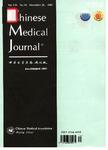Clinical Characteristics and Prognosis of Peri-strut Low-intensity Area Detected by Optical Coherence Tomography
Clinical Characteristics and Prognosis of Peri-strut Low-intensity Area Detected by Optical Coherence Tomography作者机构:Coronary Heart Disease Center State Key Laboratory of Cardiovascular Disease National Center for Cardiovascular Diseases and Fuwai Hospital Chinese Academy of Medical Sciences and Peking Union Medical College Beijing 100037 China
出 版 物:《Chinese Medical Journal》 (中华医学杂志(英文版))
年 卷 期:2015年第128卷第23期
页 面:3132-3137页
核心收录:
学科分类:0821[工学-纺织科学与工程] 1002[医学-临床医学] 08[工学] 0803[工学-光学工程] 082104[工学-服装设计与工程]
基 金:supported by a grant from the Capital Medical Development Research Foundation
主 题:Optical Coherence Tomography Peri-strut Low-intensity Area Unstable Angina
摘 要:Background: Peri-strut low-intensity area (PLIA) is a typical image pattern ofneointima detected by optical coherence tomography (OCT) after stent implantation. However, few studies evaluated the predictors and prognosis of the PLIA; therefore, we aimed to explore the genesis and prognosis of PLIA detected by OCT in this study. Methods: Patients presenting neointimal hyperplasia documented by OCT reexamination after percutaneous coronary intervention were prospectively included from 2009 to 2011. Peri-strut intensity was analyzed and classified into two patterns: Low-intensity and high-intensity. Clinical characteristics were analyzed to assess their contribution to peri-strut intensity patterns. Follow-up were performed in patients who did not receive revascularization during OCT reexamination, and the prognosis of the patients was evaluated. Results: There were 128 patients underwent OCT reexamination after stent implantation included in the study. PLIA was detected in 22 (17.2%) patients. The incidence of PLIA was positively correlated with serum triglyceride (odds ratio [OR]: 2.11, 95% confidence interval [CI]: 1.14-3.90, P = 0.017), low-density lipoprotein (OR: 2.61, 95% CI: 1.22-5.66, P = 0.015), history of cerebrovascular disease (OR: 101.11, 95% CI: 6.54-1562.13, P 〈 0.001), and initial clinical presentation of acute coronary syndrome (ACS, OR: 18.77, 95% CI: 2.73-128.83, P = 0.003) while negatively correlated with stent implantation time (OR: 0.57, 95% CI: 0.33-0.98, P = 0.043). The median follow-up was longer than 3.8 years. Major adverse cardiovascular events (MACEs) occurred in 7 (7.3%) patients while showed no correlation with PLIA. A total of 17 (17.7%) patients experienced unstable angina (UA) and showed significant correlation with PLIA (hazard ratio: 6.16, 95% CI: 1.25-30.33, P = 0.025). Conclusions: PLIA detected by OCT was positively correlated with higher serum lipid level, history ofcerebrovascular disease and initial presentation of ACS, and



